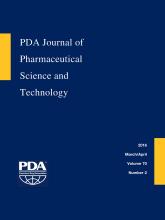Abstract
Visible particles must be monitored as part of the control strategy for pharmaceutical products. Extraneous (foreign) particles are not acceptable in parenteral drug products. In biopharmaceuticals, formation of protein particles is recognized as an inherent quality attribute. All protein therapeutics contain particles that vary greatly in visibility and size from invisible (sub-micron) to visible (millimeter) and, as part of the control strategy, biopharmaceutical companies are required to monitor and minimize the presence of visible and sub-visible particles in their products. There is an industry-wide unmet need for particle standards for visual inspection of protein therapeutics. A new, semi-quantitative method using particle standards for assessing the levels of small, inherent visible particles is presented. This method can be used during product development to identify a formulation that minimizes particle formation and also during release and stability testing to monitor and control inherent proteinaceous visible particles.
LAY ABSTRACT: Visible particles must be monitored as part of the control strategy for parenteral biopharmaceutical drug products. In these products, formation of protein particles is a natural occurrence. All protein drugs contain particles that vary greatly in visibility and size from invisible (sub-micron) to visible (millimeter), and pharmaceutical companies are required to monitor and minimize the presence of visible and sub-visible particles in their products. There is an industry-wide unmet need for particle standards for visual inspection of protein drugs. A new, semi-quantitative method using particle standards for assessing the levels of small, naturally occurring visible particles is presented. This method can be used during drug development to identify a formulation that minimizes particle formation and also during testing of final clinical or commercial drug product to monitor and control naturally occurring proteinaceous visible particles.
- Proteins
- Protein aggregation
- Protein formulation
- Stability
- Biotechnology
- Visible particles
- Inherent visible particles
- Proteinaceous
- Particle standard
- Barium sulfate
- © PDA, Inc. 2016
PDA members receive access to all articles published in the current year and previous volume year. Institutional subscribers received access to all content. Log in below to receive access to this article if you are either of these.
If you are neither or you are a PDA member trying to access an article outside of your membership license, then you must purchase access to this article (below). If you do not have a username or password for JPST, you will be required to create an account prior to purchasing.
Full issue PDFs are for PDA members only.
Note to pda.org users
The PDA and PDA bookstore websites (www.pda.org and www.pda.org/bookstore) are separate websites from the PDA JPST website. When you first join PDA, your initial UserID and Password are sent to HighWirePress to create your PDA JPST account. Subsequent UserrID and Password changes required at the PDA websites will not pass on to PDA JPST and vice versa. If you forget your PDA JPST UserID and/or Password, you can request help to retrieve UserID and reset Password below.






